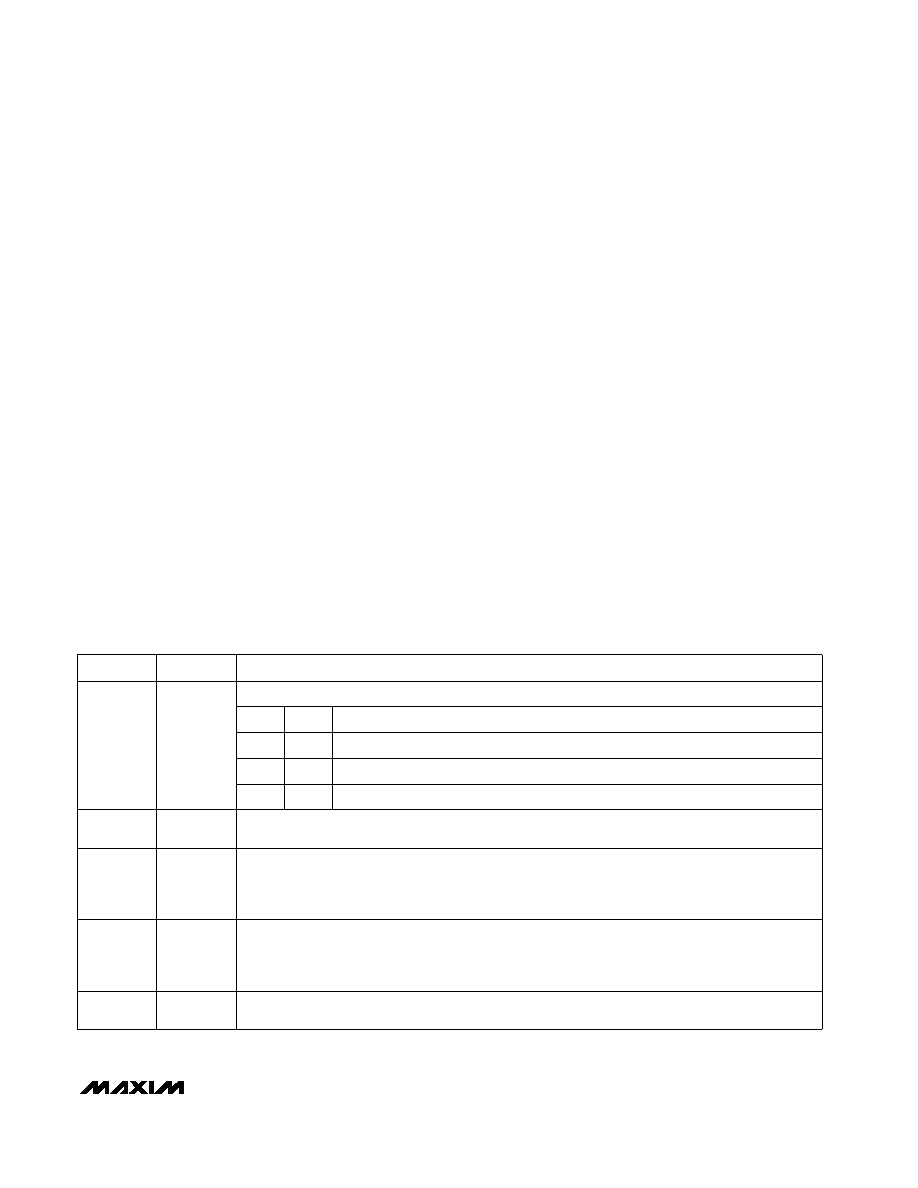- 您现在的位置:买卖IC网 > Sheet目录2007 > MAX1093AEEG+ (Maxim Integrated Products)IC ADC 10BIT 250KSPS 24-QSOP

conversion. The sampling interval occurs at the end of
the acquisition interval. The ACQMOD (acquisition
mode) bit in the input control byte (Table 1) offers two
options for acquiring the signal: an internal and an
external acquisition. The conversion period lasts for 13
clock cycles in either the internal or external clock or
acquisition mode. Writing a new control byte during a
conversion cycle aborts the conversion and starts a
new acquisition interval.
Internal Acquisition
Select internal acquisition by writing the control byte
with the ACQMOD bit cleared (ACQMOD = 0). This
causes the write pulse to initiate an acquisition interval
whose duration is internally timed. Conversion starts
when this acquisition interval ends (three external
cycles or approximately 1s in internal clock mode)
(Figure 4). Note that, when the internal acquisition is
combined with the internal clock, the aperture jitter can
be as high as 200ps. Internal clock users wishing to
achieve the 50ps jitter specification should always use
external acquisition mode.
External Acquisition
Use external acquisition mode for precise control of the
sampling aperture and/or dependent control of acquisi-
tion and conversion times. The user controls acquisition
and start-of-conversion with two separate write pulses.
The first pulse, written with ACQMOD = 1, starts an
acquisition interval of indeterminate length. The second
write pulse, written with ACQMOD = 0, terminates
acquisition and starts conversion on WR’s rising edge
(Figure 5).
The address bits for the input multiplexer must have the
same values on the first and second write pulse.
Power-down mode bits (PD0, PD1) can assume new
values on the second write pulse (see the Power-Down
Modes section). Changing other bits in the control byte
corrupts the conversion.
Reading a Conversion
A standard interrupt signal INT is provided to allow the
MAX1091/MAX1093 to flag the P when the conversion
has ended and a valid result is available. INT goes low
when the conversion is complete and the output data is
ready (Figures 4 and 5). It returns high on the first read
cycle or if a new control byte is written.
MAX1091/MAX1093
250ksps, +3V, 8-/4-Channel, 10-Bit ADCs
with +2.5V Reference and Parallel Interface
______________________________________________________________________________________
11
Table 1. Control Byte Functional Description
ACQMOD = 0: Internal Acquisition Mode
ACQMOD = 1: External Acquisition Mode
ACQMOD
D5
Full Power-Down Mode. Clock mode is unaffected.
PD1 and PD0 select the various clock and power-down modes.
D7, D6
0
PD1, PD0
BIT
Normal Operation Mode. Internal clock mode selected.
Address bits A2, A1, A0 select which of the 8/4 (MAX1091/MAX1093) channels are to be converted
(see Tables 3 and 4).
A2, A1, A0
1
Normal Operation Mode. External clock mode selected.
D2, D1, D0
UNI/BIP = 0: Bipolar Mode
UNI/BIP = 1: Unipolar Mode
In unipolar mode, an analog input signal from 0 to VREF can be converted; in bipolar mode, the sig-
nal can range from -VREF/2 to +VREF/2.
1
0
Standby Power-Down Mode. Clock mode is unaffected.
UNI/BIP
D3
0
1
SGL/DIF = 0: Pseudo-Differential Analog Input Mode
SGL/DIF = 1: Single-Ended Analog Input Mode
In single-ended mode, input signals are referred to COM. In pseudo-differential mode, the voltage
difference between two channels is measured (see Tables 2 and 3).
SGL/DIF
0
D4
FUNCTION
NAME
发布紧急采购,3分钟左右您将得到回复。
相关PDF资料
MAX1098CEAE+
IC ADC 10BIT SERIAL 16-SSOP
MAX11040GUU+T
IC ADC 24BIT 4CH 38-TSSOP
MAX11046ECB+T
IC ADC 16BIT PAR 250KSPS 64TQFP
MAX11046ETN+T
ADC 16BIT SAMPLING 8CH 56-TQFN
MAX11049ECB+
IC ADC 16BIT PAR 250KSPS 64TQFP
MAX1104EUA+
IC CODEC 8BIT 8-UMAX
MAX11100EUB+
IC ADC 16BIT SRL 200KSPS 10UMAX
MAX11101EUB+
IC ADC 14BIT SRL 200KSPS 10UMAX
相关代理商/技术参数
MAX1093AEEG+T
功能描述:模数转换器 - ADC 250ksps 4Ch 10-Bit w/Internal 2.5V ref RoHS:否 制造商:Texas Instruments 通道数量:2 结构:Sigma-Delta 转换速率:125 SPs to 8 KSPs 分辨率:24 bit 输入类型:Differential 信噪比:107 dB 接口类型:SPI 工作电源电压:1.7 V to 3.6 V, 2.7 V to 5.25 V 最大工作温度:+ 85 C 安装风格:SMD/SMT 封装 / 箱体:VQFN-32
MAX1093AEEG-T
功能描述:模数转换器 - ADC RoHS:否 制造商:Texas Instruments 通道数量:2 结构:Sigma-Delta 转换速率:125 SPs to 8 KSPs 分辨率:24 bit 输入类型:Differential 信噪比:107 dB 接口类型:SPI 工作电源电压:1.7 V to 3.6 V, 2.7 V to 5.25 V 最大工作温度:+ 85 C 安装风格:SMD/SMT 封装 / 箱体:VQFN-32
MAX1093AEEI
功能描述:模数转换器 - ADC RoHS:否 制造商:Texas Instruments 通道数量:2 结构:Sigma-Delta 转换速率:125 SPs to 8 KSPs 分辨率:24 bit 输入类型:Differential 信噪比:107 dB 接口类型:SPI 工作电源电压:1.7 V to 3.6 V, 2.7 V to 5.25 V 最大工作温度:+ 85 C 安装风格:SMD/SMT 封装 / 箱体:VQFN-32
MAX1093BCEG
功能描述:模数转换器 - ADC RoHS:否 制造商:Texas Instruments 通道数量:2 结构:Sigma-Delta 转换速率:125 SPs to 8 KSPs 分辨率:24 bit 输入类型:Differential 信噪比:107 dB 接口类型:SPI 工作电源电压:1.7 V to 3.6 V, 2.7 V to 5.25 V 最大工作温度:+ 85 C 安装风格:SMD/SMT 封装 / 箱体:VQFN-32
MAX1093BCEG+
功能描述:模数转换器 - ADC 250ksps 4Ch 10-Bit w/Internal 2.5V ref RoHS:否 制造商:Texas Instruments 通道数量:2 结构:Sigma-Delta 转换速率:125 SPs to 8 KSPs 分辨率:24 bit 输入类型:Differential 信噪比:107 dB 接口类型:SPI 工作电源电压:1.7 V to 3.6 V, 2.7 V to 5.25 V 最大工作温度:+ 85 C 安装风格:SMD/SMT 封装 / 箱体:VQFN-32
MAX1093BCEG+T
功能描述:模数转换器 - ADC 250ksps 4Ch 10-Bit w/Internal 2.5V ref RoHS:否 制造商:Texas Instruments 通道数量:2 结构:Sigma-Delta 转换速率:125 SPs to 8 KSPs 分辨率:24 bit 输入类型:Differential 信噪比:107 dB 接口类型:SPI 工作电源电压:1.7 V to 3.6 V, 2.7 V to 5.25 V 最大工作温度:+ 85 C 安装风格:SMD/SMT 封装 / 箱体:VQFN-32
MAX1093BCEG-T
功能描述:模数转换器 - ADC RoHS:否 制造商:Texas Instruments 通道数量:2 结构:Sigma-Delta 转换速率:125 SPs to 8 KSPs 分辨率:24 bit 输入类型:Differential 信噪比:107 dB 接口类型:SPI 工作电源电压:1.7 V to 3.6 V, 2.7 V to 5.25 V 最大工作温度:+ 85 C 安装风格:SMD/SMT 封装 / 箱体:VQFN-32
MAX1093BEEG
功能描述:模数转换器 - ADC RoHS:否 制造商:Texas Instruments 通道数量:2 结构:Sigma-Delta 转换速率:125 SPs to 8 KSPs 分辨率:24 bit 输入类型:Differential 信噪比:107 dB 接口类型:SPI 工作电源电压:1.7 V to 3.6 V, 2.7 V to 5.25 V 最大工作温度:+ 85 C 安装风格:SMD/SMT 封装 / 箱体:VQFN-32